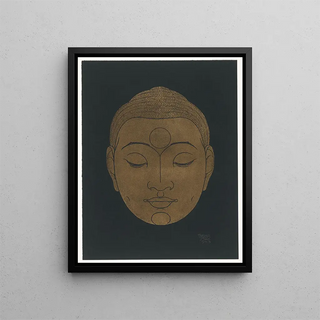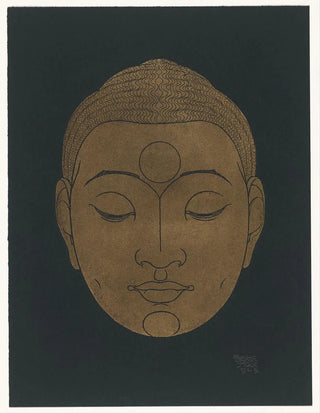Art print | Buddha Head - Reijer Stolk Source: Reproduction | Tête de Bouddha - Reijer Stolk


View from behind

Frame (optional)
Reijer Stolk’s art print of the Head of Buddha invites you on an introspective journey into the heart of Asian spirituality. This piece, imbued with serenity, evokes the wisdom and inner peace characteristic of Buddhist iconography. Contemplating this representation transports the viewer into a universe where time seems suspended, where every detail of the sculpture resonates with spiritual depth. The timeless beauty of this Head of Buddha, both simple and complex, reminds us of the importance of meditation and self-discovery—values dear to Buddhist philosophy.
Style and uniqueness of the work
Reijer Stolk’s art print stands out with a style that is both realistic and stylized, where each line and shadow is carefully crafted to capture the very essence of the depicted figure. The Head of Buddha reveals itself in perfect harmony between gentle lines and subtle volumes, creating an impression of tranquility and balance. Characteristic elements of Buddhist art, such as the serene face, elongated ears, and the bun-shaped topknot, are depicted with precision that reflects a deep understanding of symbolism. Light also plays a crucial role, highlighting contours and textures, and establishing a contemplative atmosphere. Every gaze upon this art print uncovers a new facet of its beauty, inviting an ongoing exploration of its meanings.
The artist and his influence
Reijer Stolk is an artist whose work is rooted in a respectful tradition of Asian arts while adding a contemporary touch. His passion for Eastern culture has led him to meticulously study the techniques and philosophies underpinning Buddhist art. Drawing inspiration from ancient masters while innovating with modern approaches, Stolk manages to create art prints that resonate with a diverse audience, transcending cultural boundaries. His commitment to preserving Asian artistic heritage is evident in every piece he creates, and the Head of Buddha is a striking example. Through his work, he invites everyone to reflect on

Matte finish

View from behind

Frame (optional)
Reijer Stolk’s art print of the Head of Buddha invites you on an introspective journey into the heart of Asian spirituality. This piece, imbued with serenity, evokes the wisdom and inner peace characteristic of Buddhist iconography. Contemplating this representation transports the viewer into a universe where time seems suspended, where every detail of the sculpture resonates with spiritual depth. The timeless beauty of this Head of Buddha, both simple and complex, reminds us of the importance of meditation and self-discovery—values dear to Buddhist philosophy.
Style and uniqueness of the work
Reijer Stolk’s art print stands out with a style that is both realistic and stylized, where each line and shadow is carefully crafted to capture the very essence of the depicted figure. The Head of Buddha reveals itself in perfect harmony between gentle lines and subtle volumes, creating an impression of tranquility and balance. Characteristic elements of Buddhist art, such as the serene face, elongated ears, and the bun-shaped topknot, are depicted with precision that reflects a deep understanding of symbolism. Light also plays a crucial role, highlighting contours and textures, and establishing a contemplative atmosphere. Every gaze upon this art print uncovers a new facet of its beauty, inviting an ongoing exploration of its meanings.
The artist and his influence
Reijer Stolk is an artist whose work is rooted in a respectful tradition of Asian arts while adding a contemporary touch. His passion for Eastern culture has led him to meticulously study the techniques and philosophies underpinning Buddhist art. Drawing inspiration from ancient masters while innovating with modern approaches, Stolk manages to create art prints that resonate with a diverse audience, transcending cultural boundaries. His commitment to preserving Asian artistic heritage is evident in every piece he creates, and the Head of Buddha is a striking example. Through his work, he invites everyone to reflect on






